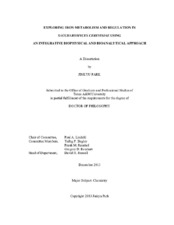| dc.description.abstract | Fe metabolism in budding yeast Saccharomyces cerevisiae was studied using an integrative systems-level approach involving Mӧssbauer, EPR, UV-Vis spectroscopy and LC-ICP-MS, combined with conventional biochemical techniques. Wild-type cells growing exponentially on rich and minimal media were well-regulated in terms of cellular Fe homeostasis, while post-exponentially grown cells were unregulated. Such cells became overloaded with Fe^(III) oxyhydroxide nanoparticles and nonheme high spin (NHHS) Fe^(III). Fe overloading probably arose from a mismatch between growth rate and Fe uptake rate. A mathematical model that describes iron trafficking and regulation in these cells was developed.
The speciation of Fe in cells also depended on the nutrient composition of the growth media. Adenine deficiency induced a transient reduction of vacuolar Fe^(III) to Fe^(II) which probably accumulated in the cytosol. The concentration of glucose impacted the Fe import rate but had little effect on Fe speciation. The concentration of amino acids and nucleotide bases impacted the level of Fe accumulation and shifted the Fe distribution toward NHHS Fe^(II). A thermodynamic model which correlated nutrient-dependent Fe transformations with vacuolar pH and redox status was developed.
The effect of deleting the MTM1 gene, which encodes a transport carrier on the mitochondrial inner membrane, was investigated. Deleting MTM1 caused Fe to accumulate in mitochondria and the Mn superoxide dismutase 2 (SOD2) activity to decline. Previous studies had concluded that this inactivation arose from the misincorporation of Fe into apo-Sod2p. Most of the accumulated Fe was found to be Fe^(III) nanoparticles which are unlikely to misincorporate into apo-Sod2p. Soluble extracts from WT and ∆mtm1 mitochondria were subjected to size-exclusion and anion-exchange liquid chromatography interfaced with an on-line ICP-MS. Two major Mn peaks were observed, one due to MnSod2p and the other to a Mn species with a molecular mass of 2 - 3 kDa. None of the Fe traces comigrated precisely with MnSod2p, contrary to the Fe-misincorporation hypothesis. Deleting MTM1 probably diminishes SOD2 activity by failing to metallate apo-Sod2 protein. The low-molecular-mass Mn species may function to install Mn into apo-Sod2p during maturation in the mitochondrial matrix, using some maturation factor imported by Mtm1p. | en |


